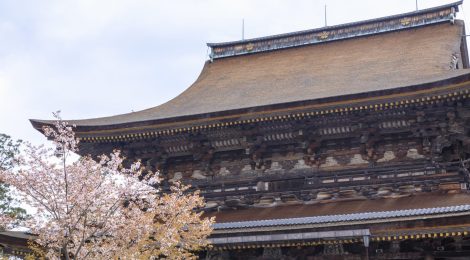
Kinpusenji Temple
Blended beliefs in mountain asceticism at Kinpusenji Temple near Mt. Yoshino
Blended beliefs in mountain asceticism can be found at Kinpusenji Temple, which is located near Mt. Yoshino in japan. This temple is part of the Shugendo sect, which combines Shinto and Buddhist beliefs. The temple complex includes Tonan-in and Sakuramotobo temples, making it one of the most important sites within the Shugendo tradition.
To reach Kinpusenji Temple, visitors can take a ten-minute walk from Yoshinoyama Station, which is the upper station of the Yoshino Ropeway. The temple is conveniently located and easily accessible for those who wish to explore its rich history and cultural significance.
One of the notable features of Kinpusenji Temple is the presence of three statues of Zao Gongen. These statues, standing at a height of seven meters, are made of blue-skinned stone and represent the past, present, and future salvation of people’s lifetimes. These ancient statues, which are over 1,300 years old, can be viewed by the public at certain times of the year.
The main building of Kinpusenji Temple, known as the Zaodo hall, is also a noteworthy attraction. It is the second largest wooden structure in Japan, following the Great Buddha Hall at Todaiji Temple. The architecture and craftsmanship of the Zaodo hall are truly remarkable, showcasing the skill and dedication of the craftsmen who built it.
Surrounded by World Heritage sites, Kinpusenji Temple holds a significant place in the region’s religious and cultural landscape. It is an important stop on various pilgrimage routes, including the pilgrimage to Mt. Omine. The entire area, which includes Kinpusenji Temple and the nearby Kinpu-jinja Shrine, is recognized as a UNESCO World Heritage site as part of the Sacred Sites and Pilgrimage Routes in the Kii Mountain Range. This designation highlights the historical and spiritual importance of this region.
In addition to its historical and cultural significance, Kinpusenji Temple also offers training events from May through October. These events focus on enhancing physical and mental endurance, exposing participants to challenging activities such as hanging off cliffs or sitting under waterfalls. These activities are rooted in the teachings of Shugendo, which emphasize the connection between physical and spiritual well-being.
One of the notable festivals held at Kinpusenji Temple is the Rengekai Toad Festival, which takes place on July 7 every year. This festival commemorates a local legend in which a man was transformed into a toad due to his lack of seriousness in religious practices. However, the story has a happy ending, as a priest later restored him to his human form. Toad and frog statues can be found throughout the town as a tribute to this legend.
In conclusion, Kinpusenji Temple near Mt. Yoshino showcases the blended beliefs of Shinto and Buddhism through its rich history and cultural heritage. The temple’s architecture, including the three statues of Zao Gongen and the impressive Zaodo hall, highlights the craftsmanship and spiritual significance of this site. Additionally, the temple’s association with the Shugendo sect and its inclusion in the UNESCO World Heritage site of the Sacred Sites and Pilgrimage Routes in the Kii Mountain Range further enhance its cultural importance. Visitors to Kinpusenji Temple can not only explore its historical and religious significance but also participate in training events and experience the vibrant festivals that take place throughout the year. It is truly a place where tradition and spirituality merge, offering a unique glimpse into Japan’s rich cultural tapestry.
Address And Maps Location:
Yoshinoyama, Yoshino-cho, Yoshino-gun, Nara-ken
Subscribe, follow @idbcpr and idbackpacker.com